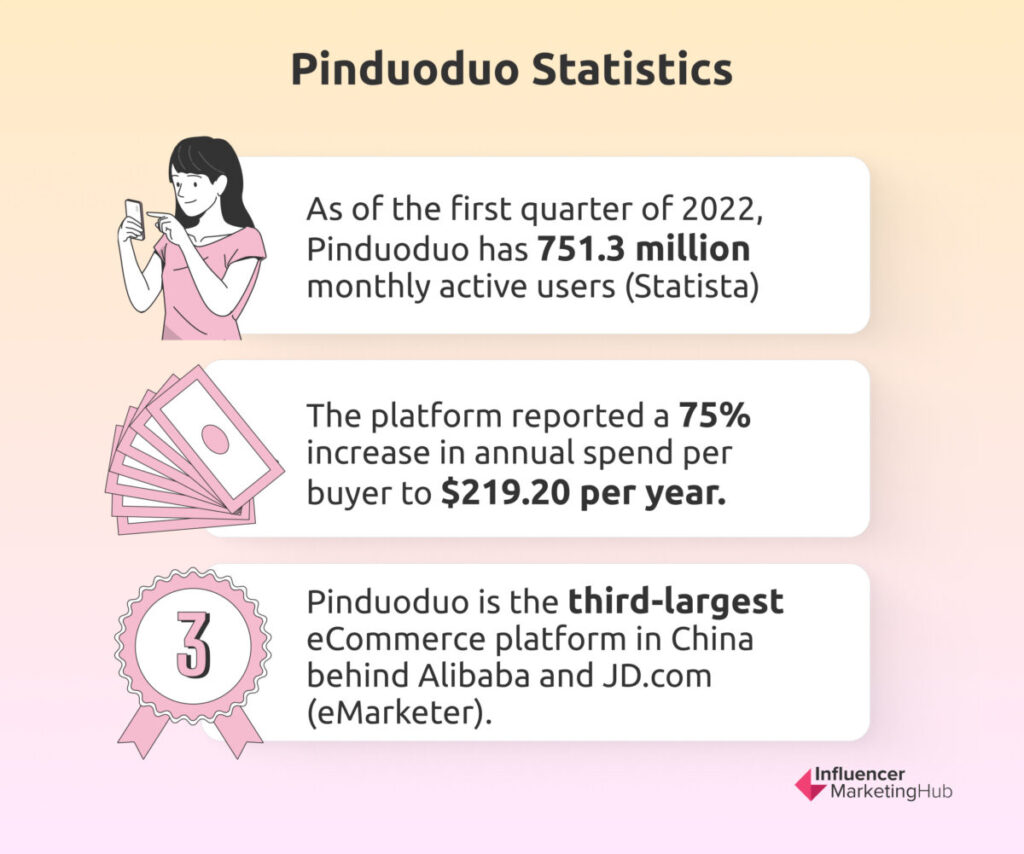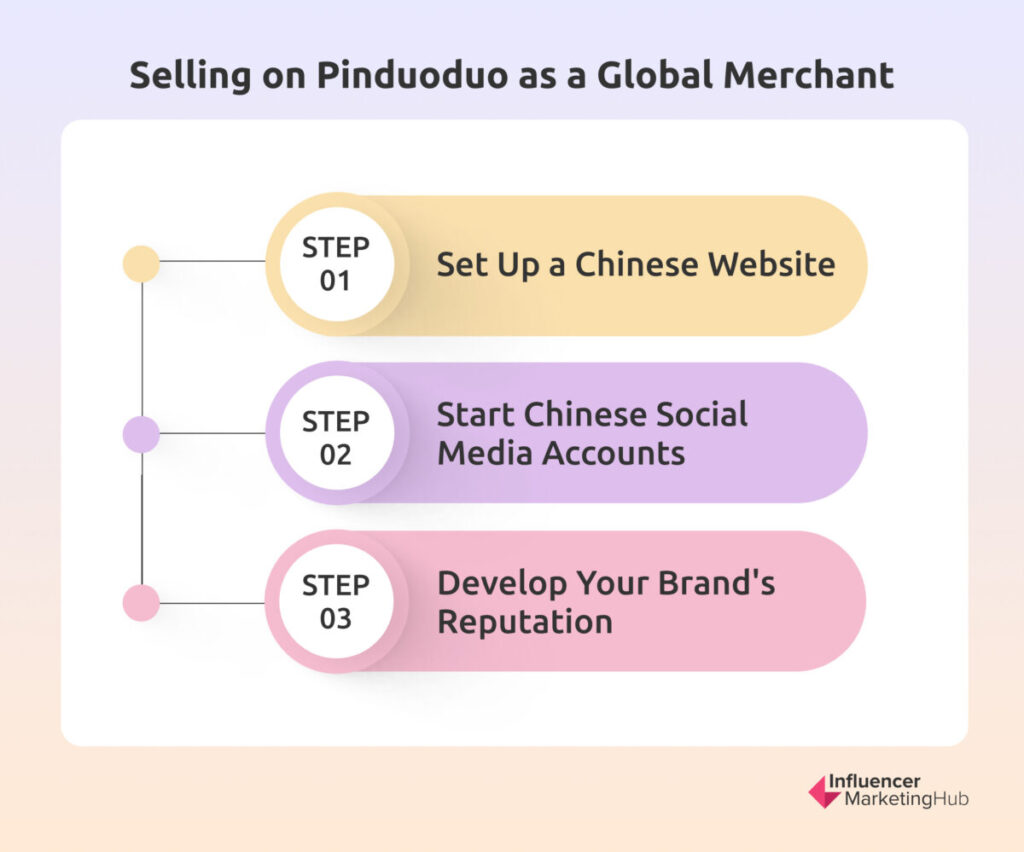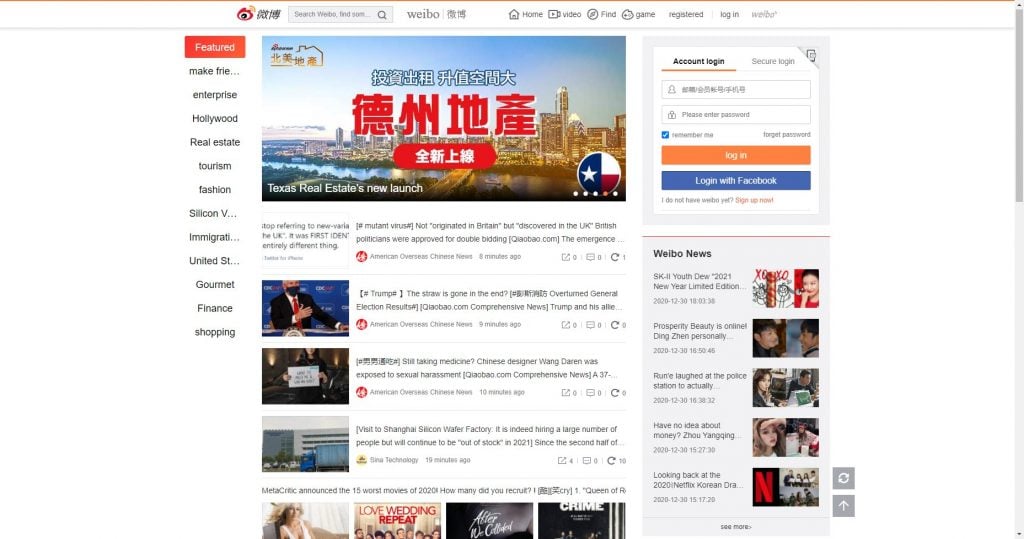Have you heard of the Chinese-based eCommerce firm Pinduoduo? If you're outside of China, you might not be super familiar with this fast-growing rival of Alibaba and JD.com but it's gaining market share fast! In this article, we'll share everything you need to know about Pinduoduo—important Pinduoduo statistics, revenue, user information, how you can get started on this eCommerce platform, and what the big deal is about social eCommerce. We've got a lot to cover, so let's dive in!
Pinduoduo: Your Ultimate Guide to China's Fastest-Growing Social Commerce Platform:
What Is Pinduoduo: Social Commerce and Affiliate Marketing

Chinese eCommerce platform Pinduoduo was founded in 2015 and offers a broad range of products—everything from day-to-day groceries to appliances for your home. As of the first quarter of 2022, Pinduoduo has 751.3 million monthly active users (Statista). This marks an increase of 3.6% from the same period of the previous year.
And it's not just Pinduoduo's user base that's big and getting bigger. As of Pinduoduo's own numbers reported to the United States Securities and Exchange Commission for 2019, Pinduoduo has 5.1 million merchants selling their products on the platform with a gross merchandise value of more than ¥1 trillion, or $154 million (Pinduoduo). In terms of revenue, Pinduoduo's latest report put them at ¥30.141 ($4.62 billion). They've also reported a 75% increase in annual spend per buyer to $219.20 per year.
So, how do social commerce and affiliate marketing fit into the Pinduoduo world?
Typically, when we think about social commerce we consider it through the lens of social media platforms like Facebook and Instagram. Pinduoduo, however, uses social networking to connect like-minded shoppers. What draws so many users to Pinduoduo is that there are benefits to making these social connections like leaderboards, animations, games, and increasing discounts.
That's right, Pinduoduo has a group buying function. When users choose a product on Pinduoduo, they can opt-in to group buying. This means that the more people who join them in purchasing that item, the lower the price of the item goes. This creates an exciting social aspect to shopping in which Pinduoduo users share links to the products they want with their networks in order to drive the price lower. There's also an air of urgency when group shopping on Pinduoduo since products have a minimum number of buyers that are required before a purchase can be completed. And, that number has to be met in 24 hours or the group buy is canceled.
Shoppers can encourage their networks to join in their group shopping using WeChat, QQ, and QR code scanning. This turns everyone into influencers for Pinduoduo and reduces the cost per acquisition for the platform because they're not running ads and are instead relying on word-of-mouth and social networking to increase interest and sales.
How Does Pinduoduo Work?
Pinduoduo operates on a customer-to-manufacturer (C2M) business model. Users can download the Pinduoduo app from the App Store or use the mini-app available within WeChat. From there, users can purchase straight from manufacturers or take part in group shopping to increase their discounts. This model puts manufacturers in control of their profit margins since there are fewer steps products must go through between themselves and customers. The C2M model can also help manufacturers reduce waste since they have a better understanding of product demand.
To make a purchase on Pinduoduo, shoppers form teams and post product listings for the items they want (typically on WeChat). Other people in their network can then decide if they want a certain product and join in on the shopping to help drive down the cost. Social commerce can also leverage virality—the more popular listings will show up in the home feeds of more users on WeChat which means more potential shoppers will see the listings and have an opportunity to join in the shopping.
Pinduoduo Statistics
Now that you know a bit more about the platform and how it works, let's take a look at the numbers. Here are some Pinduoduo statistics you'll want to know if you're considering buying or selling on the platform.

- 100% of Pinduoduo's revenue comes from "online marketplace services" that consist of commissions the platform makes from sales and advertising (CNBC).
- In 2022, Pinduoduo's revenue exceeded $18 billion, marking a growth of over 200-fold in the last six years. While this beats out Alibaba's growth in the same quarter, Pinduoduo has a ways to go to reach the $34.4 billion in revenue Alibaba hit.
- With a year-on-year growth of four percent, Pinduoduo reported roughly 751.3 million monthly active users in the first quarter of 2022.
- Pinduoduo's competitors JD.com and Alibaba reported 580 million and 1.31 billion users at the end of 2022.
- Pinduoduo has 5.1 million merchants selling their products on the platform with a gross merchandise value of more than ¥1 trillion, or $154 million (Pinduoduo).
- Pinduoduo's latest revenue report put them at ¥30.141 ($4.62 billion).
- The platform reported a 75% increase in annual spend per buyer to $219.20 per year.
- Pinduoduo can be accessed through the messaging service WeChat, giving Pinduoduo merchants access to more than 1 billion monthly users.
- Pinduoduo is the third-largest eCommerce platform in China behind Alibaba and JD.com (eMarketer).
- In 2019, Pinduoduo reported that 45% of its gross merchandising value (GMV) came from first and second-tier cities.
- 55% of Pinduoduo's GMV comes from tier-three cities or below.
- Pinduoduo went public in July 2018 on the NASDAQ with American depositary shares priced at $19 each.
- In April 2020, Pinduoduo shares closed at $50.11 each, putting Pinduoduo's market valuation at more than $58 billion. As of this writing (August 2023), Pinduoduo's share price is $90.09.
- Women make up 48.2% of Pinduoduo's user base.
- Nearly 70% of Pinduoduo's users come from tier three cities and beyond.
- Only 7.6% of Pinduoduo users come from tier-one cities.
- 63.3% of the users who make purchases on Pinduoduo are between 25 to 40 years old.
Interested in learning more about social commerce? Check out these social commerce statistics!
How to Start Selling on Pinduoduo
Pinduoduo tends to focus on lesser-known brands which might seem like a prime opportunity to use the platform's innovative social commerce-driven C2M model to promote your products and increase your sales. However, if you're not a Chinese-based company, you could have a bit of trouble. Not because the platform freezes out foreign sellers, but because China has closed communication. That means it's not likely that they've heard of you or have the opportunity to research you unless you've taken the time to cultivate a presence in China and get yourself ranked on Baidu, China's largest search engine.
If you've done all that and you're ready to sell on Pinduoduo, just go to the website and register for a seller account. You'll get to choose the type of store you have and fill out your store information before your account goes for approval. From there, you sign the contract and start selling. Oh, there is a deposit of $1500–$7600, depending on which industry you're in. The deposit is used to pay back unhappy customers and it's refundable if there aren't any problems with your products. Pinduoduo doesn't make commissions from your product sales but does charge a 0.6% service fee.
What to Do If You're Not Based in China

If you're not based in China, Pinduoduo has a registration option for you, too. However, gaining an audience in China as a foreign business isn't just as easy as putting your products up on the platform and hoping for the best. Since Pinduoduo is largely based on Chinese social media, you'll need to take steps to build your online reputation on those platforms. Here are the steps we recommend taking if you want to start selling on Pinduoduo as a non-Chinese business.
Step 1. Set Up a Chinese Website
While it's true that many people in China speak English, the number of English speakers only make up 0.71% of the total Chinese population. This makes it important to create a website specifically for the Chinese-speaking audience you're trying to reach, registering the site with a Chinese domain, designing it based on local Chinese standards, and working to get it ranked on Baidu.
Step 2. Start Chinese Social Media Accounts
There are a few Chinese social media platforms you'll want to at least be aware of, even if you decide not to create accounts on those platforms.
WeChat (微信; Wēixìn)
User Statistics:
Monthly Active Users: 1.3 Billion (Q1 2023)
Average Daily Active Users: 614 million (July 2023)
DAU of WeChat Mini-Programs: 600 million (Q1 2023)
WeChat Penetration Rate Among 16-64-Year-Olds In China: 78% (Oct 2018)
WeChat is typically referred to as the Facebook of China or the "everything app." It's definitely the most-used social media platform in China with more than 1.3 billion users. WeChat comes with features that you'll find in Facebook Messenger and payment gateways like Venmo. Users can use the platform to share content with their friends, order movie tickets, taxis, or other daily services, and, of course, find out the information they need about their favorite brands. If you're planning to do business in China, a WeChat account is mandatory.
Weibo (微博; Wēibó)
User Statistics:
Monthly Active Users: 593 Million (Q2 2023)
Average Daily Active Users: 255 million (Mar 2023)
Mobile Monthly Active Users: 95% (Q2 2023)
Average Visit Duration: 9 minutes 7 seconds (August 2023)
Weibo, or Sina Weibo, is like a Chinese version of Twitter (Twitter isn't accessible in the country). Since 140 characters in Mandarin can convey much more information than the same number of characters in English, Weibo is considered a microblogging platform and, in fact, is the most popular blogging platform for Chinese users. Companies who use Weibo can share information-laden posts with Weibo users who engage on the platform with influencers, celebrities, and others with similar viewpoints.
DouYin (抖音; Dǒuyīn)
User Statistics:
Global Monthly Active Users: 800 Million (Q2 2023)
China Monthly Active Users: 518 Million (Q1 2020)
China Daily Active Users: 150 Million+ (Q1 2020)
Average Time Spent Per Day: 108 minutes
Like its non-Chinese counterpart TikTok, businesses can use DouYin to create short-form video content and post ads. Given its enormous growth over the past few years, it's likely that DouYin will overtake other Chinese social media platforms in terms of popularity.
Step 3. Develop Your Brand's Reputation
Once you have your website set up and are ready to post content on your chosen social media platforms, you'll need to develop your brand's online reputation as a trusted and reliable brand. This means taking every opportunity to connect with your target audience and be of value to them, collaborating with influencers, and getting your brand noticed... in a good way.
It's important to remember that building your brand's reputation is going to take time. Be patient and diligent and you'll be rewarded!
Marketing Your Brand and Products on Pinduoduo
Fortunately for merchants, Pinduoduo has been developing a social eCommerce platform that makes it fun to shop online with friends. To get the most out of your Pinduoduo experience, consider using these pricing options on the platform:
- Limited Purchase. Set up a discounted price based on a certain quantity. After that quantity has been sold, the pricing will be set to the standard, non-discounted rate.
- More, Cheaper. Set up your pricing so that the price decreases depending on the conversion rate. This means that as more people order, the cheaper the product becomes (and you sell more).
- Limited Time. Buyers must purchase the product in a limited time. Then, a part of the order is distributed as platform coupons.
In addition to specialized pricing, Pinduoduo gives merchants the option to use influencers (known as Key Opinion Leaders, KOL, in China) to promote their products via live streaming. Influencer marketing is a huge business in China, with KOLs opting to take official training to learn influencer marketing techniques that drive conversions.
Finally, good old SEO, PPC, and banner ads can help build up your brand image and draw an audience to your online store. Like Google and other Western search engines, China's Baidu uses its own algorithm and SEO signals. Using Baidu best practices will help you generate buzz and increase traffic to your online store.





